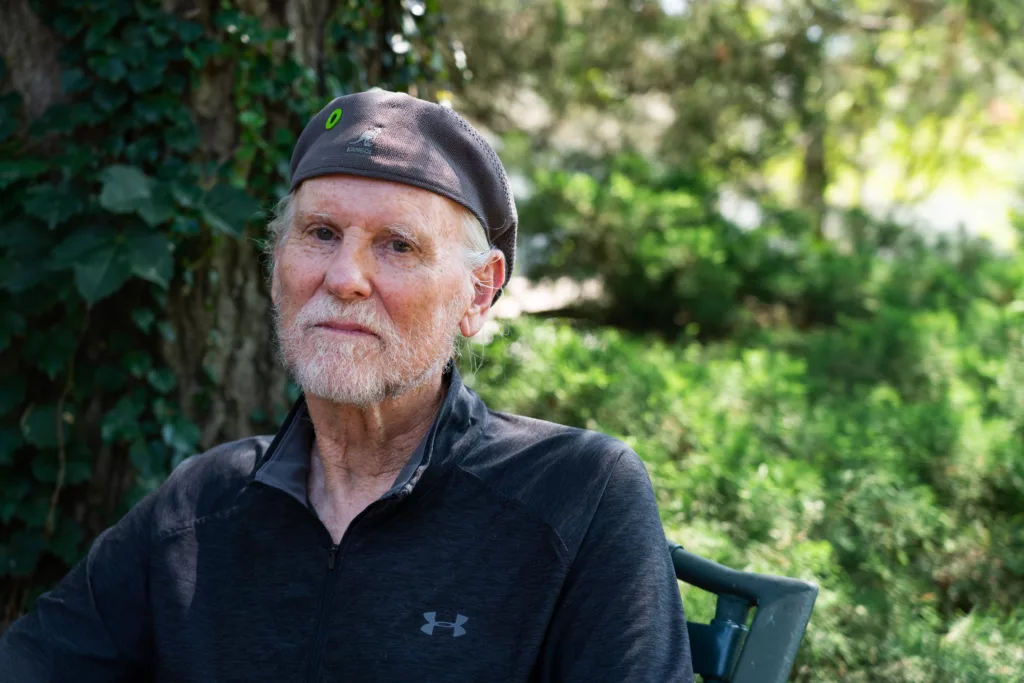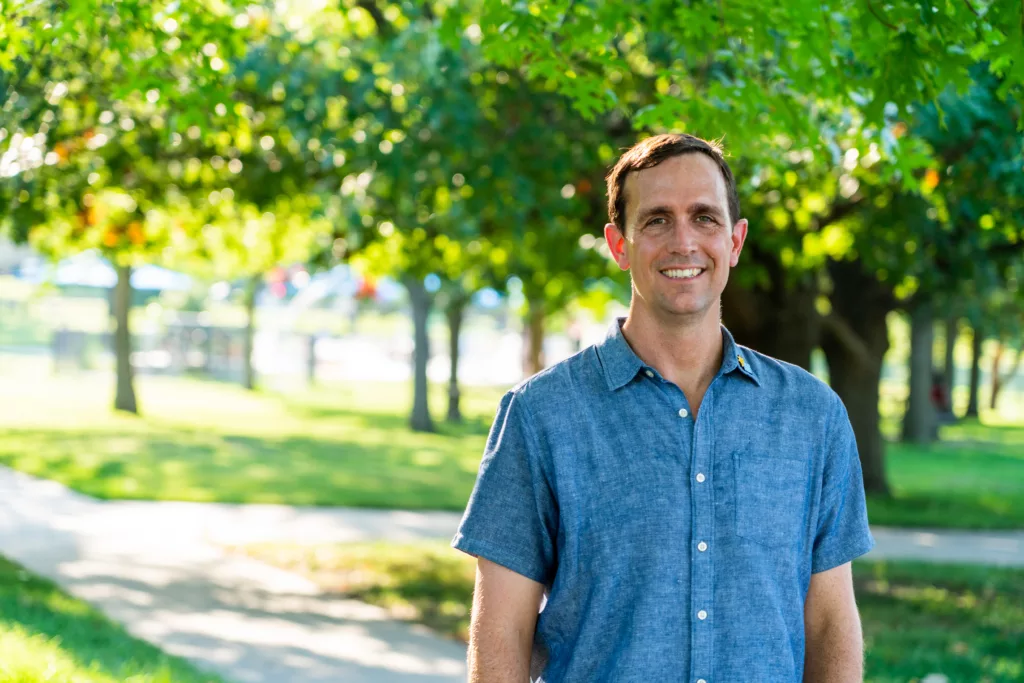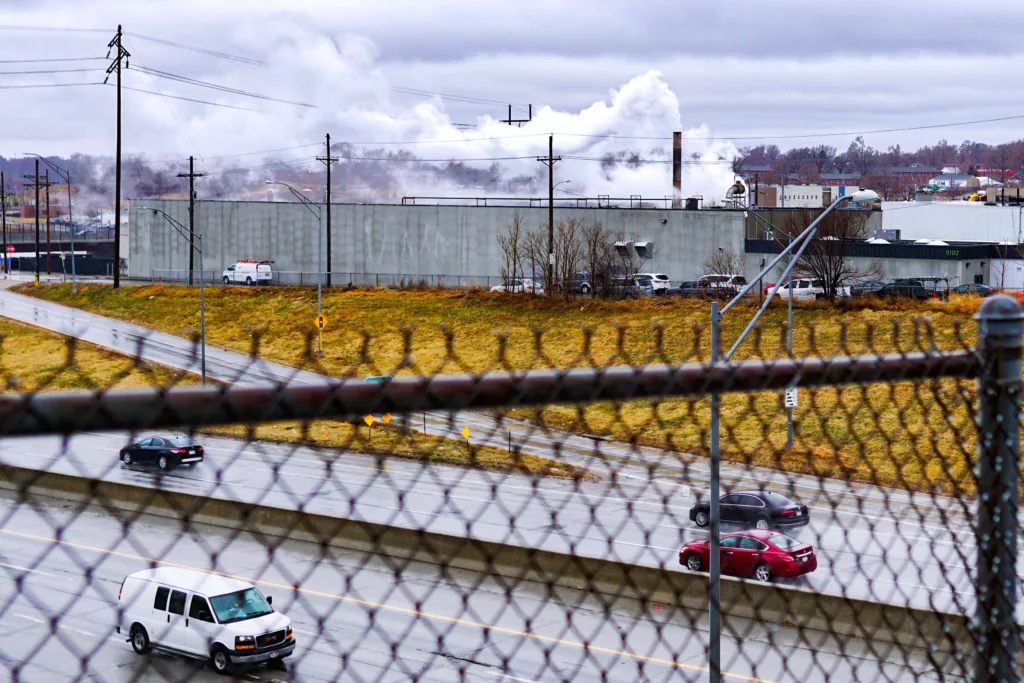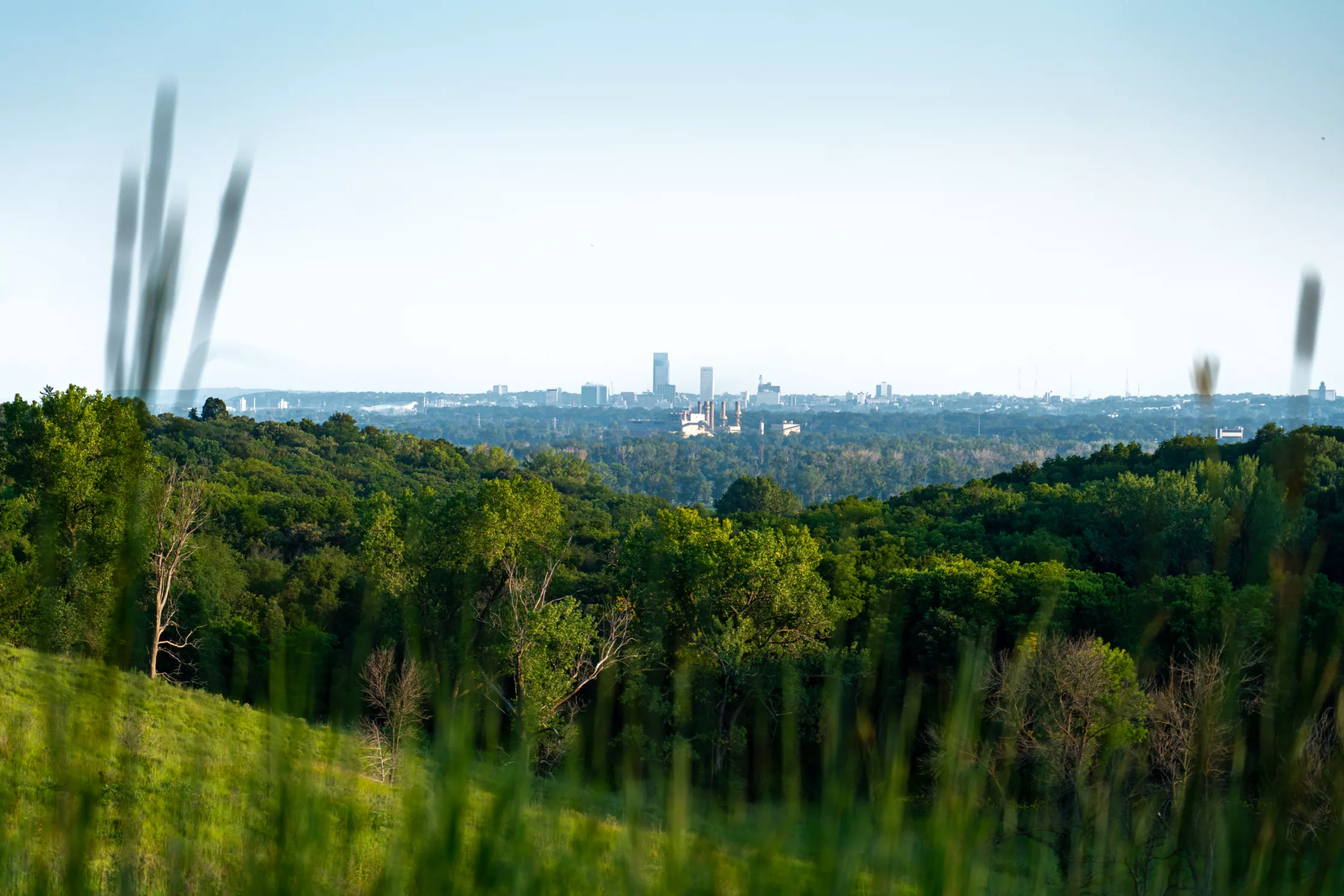The sun ascended into a vacant late-summer sky as the concrete baked below. Later that day, Omaha’s heat index would reach 109 degrees. But even at 8 a.m., it was too hot for Mike McMeekin, who retreated into an air-conditioned coffee shop.
McMeekin, an engineer and occasional political player in Omaha, was, in a way, there to talk about the weather — specifically storms, droughts, snow, floods and heat waves, which are getting worse in Nebraska as a result of human-influenced climate change.
State research suggests Nebraska’s average temperatures could climb 9 degrees by the end of the century, generating more extreme weather, scorching days and threatening public health.
Omaha hopes to help curb, or at least withstand, these changes with its Climate Action and Resilience Plan.
The plan, which will identify strategies to reduce Omaha’s vulnerabilities — and contributions — to climate change, is slated for release in November 2024.
A contractor is tallying Omaha’s greenhouse gas emissions while the city looks to hire a full-time employee to oversee the plan. A website to track progress will soon be available along with an online survey for people to share ideas. In-person forums will start by the end of the year.
For some, this movement represents an optimistic shift for Omaha. Others are getting déjà vu.
“I feel like we already have (a plan),” McMeekin said.
In 2010, Omaha’s City Council approved the Environment Element of its Master Plan — a 152-page document developed by volunteers and partially steered by McMeekin. It included hundreds of proposed strategies and more than 30 goals, ranging from reducing greenhouse gasses and increasing renewable energy resources to updating building codes and creating denser development.
The city has failed to meet most of those goals, costing the metro at least $1.39 billion in energy savings and a 23% reduction in energy consumption, according to projected figures in a 2011 city report.
City officials argue the 2010 plan proposed too much without setting priorities or suggesting how Omaha would secure the needed funding or manpower.
Others say it comes down to politics.
The plan was conceived, and began implementation, under Mayor Jim Suttle, a Democrat. It fell apart under Mayor Jean Stothert, a Republican, who took office in 2013 and has instead prioritized public safety and trimming budgets.
Indeed, a decade’s worth of city emails obtained by The Reader shows officials in city government rarely discussed climate change or the 2010 plan.
Now, many Omahans feel like the city is back to square one.
“If you look at the things that we decided about, it’s what we’re still talking about today,” said David Corbin, a longtime environmentalist and local Sierra Club leader in Omaha. “Energy efficiency, climate change, greenhouse gasses. We made recommendations and they still didn’t happen.”
Omaha is now one of the few large American cities without a climate plan, being outpaced by others such as Minneapolis, Des Moines and Chicago. Lincoln, which has a Democrat-controlled city council and mayor, passed its plan in March 2021. Nebraska’s Legislature, officially nonpartisan but ultimately majority-Republican, rejected 2020 calls to develop a plan for the state.
Some cities, such as Cincinnati, can offer insight into how to make a plan not only sound good but also work — something that eludes most major cities, which aren’t meeting their climate goals, according to research from the Brookings Institution.
“We don’t want a plan on a shelf,” said Marco Floreani, a deputy chief of staff for the mayor who is leading her climate plan effort. “We really want a plan that can be implemented.”
But the initiative has faced setbacks and delays. Stothert first called on city, business and nonprofit leaders to lead the effort in February 2021. The city officially hired a contract in August.
“The track record for the city is abysmal,” said David Holtzclaw, an environmental engineer whose company, Transduction Technologies, consults on energy efficiency. “I can’t point to a single success or a single reason to have hope. It’s a plan that will sit on a shelf, much like the (2010 plan) … What has come of that? Nothing.”

McMeekin doesn’t want to see the city fall further behind.
“I just feel strongly like, ‘Hey, if we had implemented (the 2010 plan), we would essentially have had a climate action plan,” McMeekin said. “We’d be years ahead on things that we’re kind of starting over on now.”
‘The Forgotten Plan’
When it comes to environmentalism in Omaha, Corbin has learned to measure success in small steps. The Earth Day crowds listening to him perform Neil Young songs have gotten bigger. More people believe in climate change — 68% of people in the Omaha metro area believe global warming is happening and 55% say local officials need to do something about it, according to 2021 Yale research.
The 2010 plan wasn’t a small step.
“It was very ambitious,” said Corbin, a retired public health educator who served on the plan’s community health committee. “I think people really felt that it could make a difference. And that we weren’t wasting our time — that something would come of it.”

Those efforts started in November 2008, part of a larger push by city, nonprofit and business leaders to reinvent Omaha into a lively metro rather than the suburban sprawl it had become by the mid-2000s. It defined the city’s natural environment, construction patterns, natural resources and urban design. It took two years to develop.
But the plan lacked direction among its 681 recommended actions, said Derek Miller, head of long-range and mobility planning for the city and whose office oversees the 2010 plan.
“It’s not actionable,” said Miller, who served on the plan’s urban form and transportation committee. “It doesn’t say, ‘If you do this every year for the next 10 years, then you can reach your goals.’”
Some point to the 2013 election of Stothert, who through a spokesperson referred all questions about climate work to Floreani, as a turning point.
From 2009 to 2013, the city had an Office of Sustainable Development, a four-person team funded by about $14 million in federal grants. It carried out the 2010 plan through projects such as updating 1,360 homes and 43 commercial buildings to be more energy efficient, saving their owners a combined nearly $800,000 in energy costs.
Stothert cut the office after its grant expired. Since 2017, the city has updated about 127 homes through a similar program, according to Wyatt Tuell, a city planner who oversees the program.
Some of the work started by the sustainability office has continued, said former staff member Eric Williams, who is now chair of the Omaha Public Power District Board of Directors.
In 2011, the Office of Sustainable Development changed most of the city’s traffic signals to LED bulbs. Williams said streetlights were to be the next step before the office disbanded. In 2018, OPPD picked up the work. From 2020 to 2023, it changed thousands of streetlights to LED bulbs. That coincided with a $2.5 million reduction in the city’s annual electricity bill.
Remembering these missed opportunities makes it hard for Williams to take the city seriously when it promises this time will be different.
“I’m sure you’ll find a bunch of people who have grown weary of completing a plan that highlights benefits for the community, that then does not translate into any specific action,” Williams said.

City emails obtained by The Reader didn’t reveal much commitment. From 2013 until the city pursued a new climate plan in 2021, officials in the mayor’s office and members of the Omaha City Council rarely discussed climate change.
More often, they would respond to (or ignore) constituents concerned about city decisions, such as a mayoral veto of a plastic bag ban in 2019 or passing a waste collection contract that scaled back composting the same year. The city now composts about a sixth of what it did in 2005, though recycling is up about 35%, according to city estimates.
Dozens of Omahans emailed the mayor in 2017 when President Donald Trump pulled out of the Paris Agreement, an international commitment reached two years earlier to reduce greenhouse gas emissions. As more than 400 U.S. mayors reaffirmed their support for climate action, Stothert sent constituents an email cataloging the city’s recent environmental work. She did not mention climate change or the reaction from other mayors.
Still, the city has made strides.
It’s spending $2 billion to update its sewers to discharge cleaner water into the Missouri River — part of a federal mandate. It will also soon be able to sell natural gas harnessed from methane captured at its primary wastewater treatment plant. Waste collection trucks contracted by the city run on natural gas, and there are 70 free electric vehicle charging stations in the city, according to ChargeHub.
In 2020 the regional transit authority introduced its first rapid-transit bus line. The city is working on a $306 million streetcar, projected to open in 2026, which the city hopes will generate $3 billion in investment in its urban core, attract a younger workforce and take cars off the road as people use multi-model transit.

The city also adopted policies such as Complete Streets, which prioritizes multi-modal transit, and Vision Zero, which aims to make streets safer.
And while the city didn’t meet many of its 2010 goals, it has made progress. With a formal plan, it can go even further, Miller said.
“Like most communities, we’re more reactive than proactive … we need to become more proactive with (climate change),” Miller said. “So I’m excited for this climate action plan. And I think using the experience that we went through with the Environment Element, we can figure out what went well, what didn’t go well and what we need to do differently.”
Not Rocket Science
Pete Festersen, a longtime Omaha City Council member and current president, represents midtown Omaha, including his own neighborhood in Dundee, where many bike, install solar panels and fill gardens with flowers and produce. He served on the committee that produced the 2010 plan — and like many others has watched climate action sputter here.
Chief among his complaints is the city has no employee whose sole focus is climate action. That should change soon as the city announced in late August it would hire a full-time staff member to oversee the plan.
“That’s best practice everywhere this has been done,” Festersen said, “and I think that’s part of the challenge we’re experiencing right now with some of these delays and clunky timelines.”
After Stothert launched the effort to craft a plan in February 2021, it spent more than a year lingering inside Metro Smart Cities, a group of civic, business and nonprofit leaders. In September 2022, Festersen tried to fold the plan into the city’s budget, a resolution that the mayor vetoed.
In March 2023, Omaha selected Minnesota-based contractor paleBLUEdot to lead climate planning and local consulting firm HDR to lead community engagement. However, the $376,000 contract wasn’t signed until August due to a change in funding.
Floreani said despite the delays the city is headed in the right direction.
“Young people have said that this is an important issue and they want to be in a community that’s focused on adaption and being proactive,” Floreani said. “From a business perspective, too, companies are thinking about risk. They want to be in a community, or they want to grow in a community, that is serious about future risks.”
The agreement the city signed with paleBLUEdot, which has completed climate action plans in cities such as La Crosse, Wisconsin; Bloomington, Indiana; and Hartford, Vermont, calls for research into environmental policy, community engagement and an inventory of the city’s greenhouse gas production.
The final plan was slated to take 18 months and arrive in June 2024. That has since been pushed back to November 2024, said Ted Redmond, co-founder of paleBLUEdot.
Jesse Bell, a climate and health scientist at the University of Nebraska Medical Center, said this plan will answer many unknowns about Omaha’s climate vulnerabilities.
“We will see changes in heat waves, flooding, droughts, severe storms,” he said. “What does that potentially mean for Omaha? Where are susceptible populations? What are those issues within infrastructure? There’s still work that needs to be done.”
Some are digging deeper into those questions. UNMC research is examining urban heat islands: neighborhoods with fewer trees, green space and water which, in Omaha, can be nearly 10 degrees hotter than other areas. Children have higher rates of asthma in east Omaha, where more poor and communities of color live alongside industrial pollution, studies show. Temperature increases are also leading to longer allergy seasons as well as leading more virus-carrying ticks to Nebraska.

But to go any further, Bell said comprehensive research and prioritized strategies are needed.
So far, Bell is optimistic the city will accomplish that. When the city was reviewing applications, Floreani called Bell and asked for his help.
“The fact that they even reached out to me, I felt like they were taking it seriously,” Bell said. “It wasn’t just we’re going to do this to do it. And when I talked to (Floreani) he seemed really invested in it. I was impressed.”
Redmond with paleBLUEdot isn’t worried that his firm will come up with an actionable plan. It’s sticking to it that’s challenging.
“This is not rocket science,’ he said. “We know the things that we need to do. But it is really hard to get it to happen.
Across the River
Since 1991, more than 600 local governments across the U.S. have passed climate action plans. But just passing a plan isn’t enough.
A 2020 study from the Brookings Institution found two-thirds of the largest cities that made commitments to lower greenhouse gas emissions were lagging on their targets. A primary reason? The goals aren’t adopted into policy.
Cincinnati, Ohio – a city that shares many similarities with Omaha – hasn’t had that problem.
Since passing its Green Cincinnati Plan in 2008, the city has reduced carbon emissions by 36.6% and aims to reach carbon neutrality by 2050. The city also is involved with what’s being called the largest municipal solar farm in the nation — a site the size of 680 football fields with 310,000 solar panels — as part of its plan to use 100% renewable energy for city operations by 2035.
“At the end of the day, I think it’s about people’s commitment to making it happen and being able to find alternative approaches,” said Oliver Kroner, sustainability director for the City of Cincinnati.
In 2023 the city updated its plan for the fourth time. Over six months, the city’s sustainability office gathered suggestions from 3,766 residents through in-person and virtual meetings as well as surveys, one of the most extensive engagement processes the city has ever done, according to the report. The city’s online climate dashboard now includes 130 recommended policies or commitments.
“We’re doing everything we can to eliminate our 3.5% of the carbon pie, but there’s much more focus on bringing partners into the fold and understanding where we can build relationships that can help us go further faster.”
The need for leadership became clear when President Trump pulled out of the Paris Agreement, Kroner said. Suddenly Cincinnati, which has primarily had Democratic mayors since the early 1970s, had to come up with its own answers.
The energy required to power buildings accounts for 39% of global emissions, according to the International Energy Agency, although that number is typically higher in cities.
To lower emissions, Cincinnati has built networks through its 2030 District — an initiative in 24 U.S. cities that calls on businesses to reduce energy consumption, water usage and transportation emissions to zero by 2040.
Cincinnati’s partners include Fortune 500 companies such as Procter & Gamble and Kroger as well as museums, breweries and cafes. In total, they represent 28.2 million square feet of commercial space.
Other cities are on similar tracks.
Last year, Des Moines had the second-most buildings of any mid-sized city certified as Energy Star, a standard for extremely efficient buildings. Des Moines’ 49 buildings collectively saved $1.8 million in energy bills and averted 10,700 metric tons of carbon dioxide, according to data from the federal government.
By comparison, Omaha had nine buildings certified last year. Lincoln had 12, nine of which are Lincoln Public Schools buildings.

Holtzclaw, owner of the consulting firm Transduction Technologies, has been hard at work pitching energy-efficiency upgrades to businesses around the country — especially since the passage of the Inflation Reduction Act, a federal bill that has created significant tax incentives for such work. Ironically, Nebraska is where he’s had the least luck, he said.
“I will make the same pitch to somebody in Des Moines or Minneapolis and they’ll be like, ‘Where do I sign?’” Holtzclaw said. “Here, it’s the same pitch. They’re making the same amount of money, I do the same work. I follow up like three or four times and never hear back.”
It’s not true to say Omahans don’t care about sustainability or climate change, according to 17-year-old climate activist Kiera Ginn.
While the City of Omaha does not have a climate plan, other institutions in the city do. They include: the University of Nebraska at Omaha, Creighton University, the University of Nebraska Medical Center, OPPD, Metropolitan Utilities District, Union Pacific, Kiewit and Werner Enterprises.
But Ginn and others in the citywide group Students for Sustainability have questions. Is everyone working together? Is addressing climate change really a priority? Are we moving fast enough? And where are we heading?
Earlier this year, they offered to help the city with its climate action plan. They had a meeting, but that was months ago. They haven’t heard much since.
So, like many others, they’re hoping for the best. But growing up here, they’ve also learned to measure their expectations.
“In a sense, it’s discouraging,” Ginn said, “but it’s also expected from Omaha.”
McMeekin shares those mixed feelings. The city is making promises, but he’s heard those before.
Earlier this year, the world’s top scientists released a hulking assessment on everything we know about climate change. The outlook has only gotten more grim.
“This report is a clarion call to massively fast-track climate efforts by every country and every sector and on every timeframe,” United Nations Secretary-General António Guterres said in March. “Our world needs climate action on all fronts: everything, everywhere, all at once.”
Omaha may have missed its chance to launch into climate action in 2010. But it’s not too late, McMeekin said. And the city doesn’t need to solve the world’s climate problems. It doesn’t even need to fix all of its own right now.
It just needs to find somewhere to start, he said.
This story is part of The Reader’s Climate Beacon Newsroom initiative with Solutions Journalism Network.



1 Comment
It is said up to 97% of climate scientist agree with the climate change theory. The problem is, more scientific disciplines should be involved becasue the climate scientists don’t have the expertise for many of the investigations on climate change one way or another. When people the worse X weather in history, what does that mean. By manipulating dates one can prove almost any claim of what is the worse weather ever. Climbing temps can not be stopped or reversed for hundreds or even possibly thousands of years. Adaptation is needed now. Not a destroyed economy to satisfy a few climate zealots. The claim that climb change is settled science means two thing, it is not science because in science the process demands further investigations for ever if necessary. The theory of climate change hasn’t been verified by scientist outside the climate change group. Current models can’t even predict past weather. While still having all the information from the past weather. None consider all the variables in such modeling. Many models are based on biased assumptions. Not scientific fact.